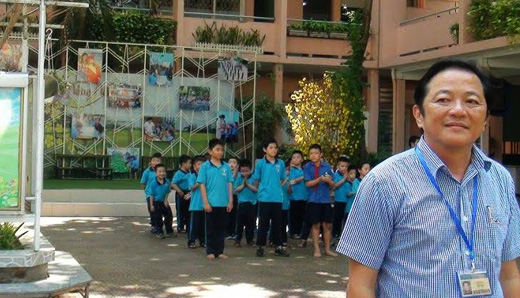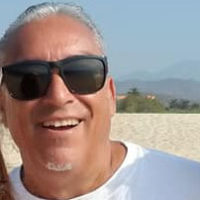
HO CHI MINH CITY, VIETNAM — The sounds of laughter could be heard throughout the halls and into the classrooms. Children were playing with a soccer ball in the outside school court. This joyous sound of laughter was not a distraction to the students in the classrooms. In fact the children seemed content to know that their classmates were actively participating in the scheduled recreation time.
Students during this recreation time could participate in playing outside, participate in exercise-Tai Chi style or participate in dancing Zumba style, with all activities occurring outside in the school courtyard. Inside students could get instructions in an art class or watch a teacher play guitar in her music class. All under the inspirational eyes of Ho Chi Minh. Every classroom had a statue or portrait of Ho Chi Minh.
At the Hoa Binh primary school located in the center of Ho Chi Minh City teachers greeted our delegation dressed in traditional Vietnam dresses. School children invited us to participate in a group sing-along. The children playing outside waved and greeted us with smiles saying in English “Hello. How are you?”
The headmaster of the school greeted us and gave us a tour of the school describing the classrooms and the course students take during the year. Students everywhere seemed excited that we came to visit their school.
The Vietnamese people respect education and place a high value on learning. Lessons were learned from the colonial exploitation by the French who excluded the Vietnamese from educational opportunities. Only the so-call French elite were allowed to participate in educational activities. During the Vietnam War many schools were destroyed or damaged, and classes were forced to be cancelled. This experience motivated the Vietnamese people to make education a priority. The Vietnamese people have made tremendous advancements in its educational system.
“The education system is divided into five levels: pre-primary, primary, intermediate, secondary and higher education,” said the headmaster of Hoa Binh school. “Vietnam has a relatively high standard of education. As you can see our children here normally start primary education at age six. Education at this level lasts for 5 years and is compulsory for all children.”
Today, primary education is compulsory and tuition “free.” According to the General Department of Statistics of Vietnam, the national literacy rate in Vietnam has reached 97.3 percent for those aged 15-50. Technology also figures into learning at an early age. Nearly all 6-year olds and 43.7 percent of laborers have basic knowledge of computers.
Some shortcomings do exist in the educational system. There is limited training of teachers, inadequate instructional methods and inconsistent management. However, educators say these are obstacles that will be overcome in time.
University of Medicine and Pharmacy
The University of Saigon was established in 1947. Following the Reunification the country, the University of Medicine and Pharmacy was founded in 1976 in Ho Chi Minh City. In 1998, the university was expanded to train auxiliary medical staff, and in 1999 the Faculty of Public Health was founded. In 2000, the University opened its own medical center with 250 beds.
Dr. Tran Diep Tuan, President and Associate Professor of Pediatrics, provided excellent information regarding the University. At a formal meeting with faculty and students Tran Diep Tuan said “Our university is a leading teaching institution in health sciences. We have the mission of educating and training healthcare professionals, who are able to provide healthcare to people towards [the goals of] effectiveness and equity.”
Everyone at the meeting spoke English. The students, faculty and the President all insisted that the meeting be held in English. Dr. Tuan and the staff made clear with great pride that the University throughout the years of its existence has been recognized as one of the leading institutions in medical education in Vietnam. Dr. Tuan also told us that “faculty members have been awarded many medals and certifications of merit to recognize their continuous endeavors to improve the quality of medical education.”
The University has over 10,000 students. It is by far the largest medical teaching institution in Vietnam, this according to President Tran Diep Tuan.
It’s clear that the people of Vietnam have invested a lot in their educational system. They believe that education will ensure a positive future for the country. Vietnam has a population of over 80 million people with 70 percent under the age of 35 years; one can understand why Vietnam places a high premium on education.
Photo: Children line up in the courtyard at the Hoa Binh Primary School in Ho Chi Minh City. The school’s principal stands to the right. | John Bachtell/PW









